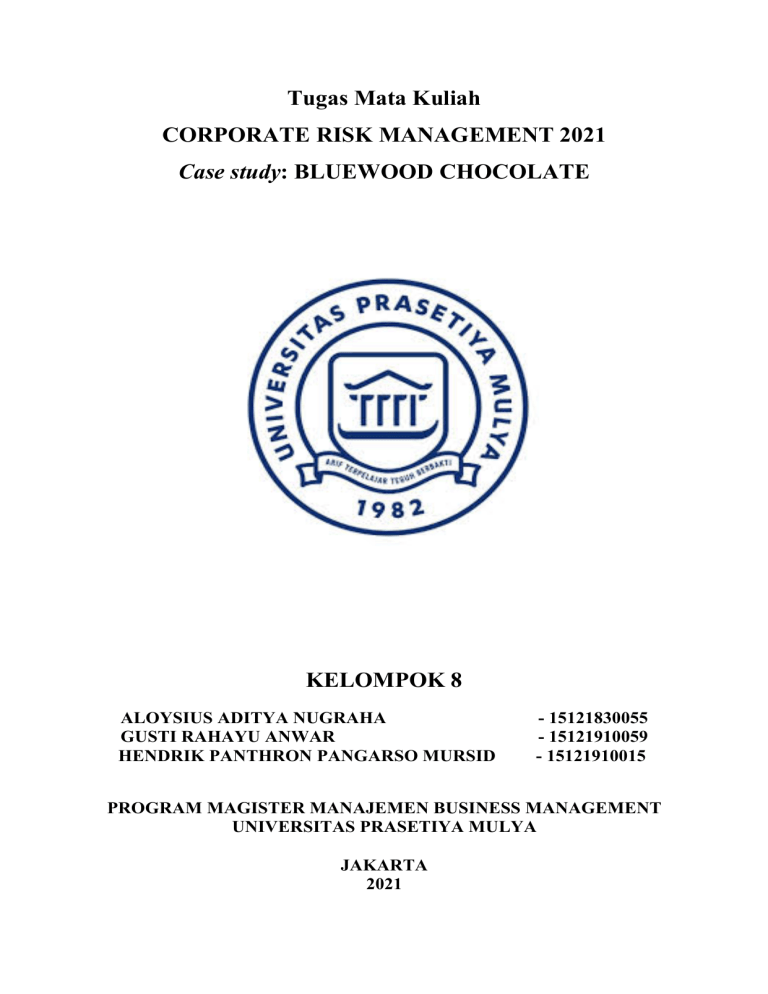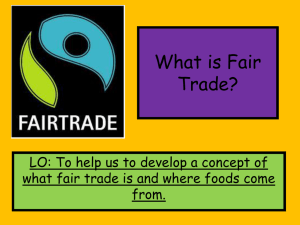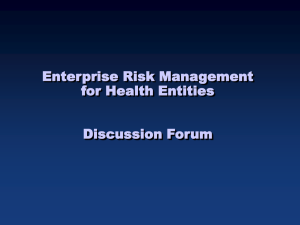
Tugas Mata Kuliah CORPORATE RISK MANAGEMENT 2021 Case study: BLUEWOOD CHOCOLATE KELOMPOK 8 ALOYSIUS ADITYA NUGRAHA GUSTI RAHAYU ANWAR HENDRIK PANTHRON PANGARSO MURSID - 15121830055 - 15121910059 - 15121910015 PROGRAM MAGISTER MANAJEMEN BUSINESS MANAGEMENT UNIVERSITAS PRASETIYA MULYA JAKARTA 2021 I. BUSINESS OVERVIEW Bluewood is a medium chocolate company based in the U.S.A, built by John Ferguson Senior around 50 years ago. The Bluewood is named after its blue warehouse in his family building where he used to play around during his childhood. As a bulk chocolate producer, Bluewood received cocoa from U.S based importers as well as self-imported it from Brazil, Ecuador, Costa Rica, and Dominican Republic. It runs Business to Business type by spreading the output to the whole country before exporting Canada, Mexico, and Eurozone with 75% and 25% share. Due to founder limitation, and regeneration for the company, he transferred his leadership to his son John Ferguson Junior. II. PROBLEMS Bluewood is owned by 4 big parties (Figure 1) where it has its own interests or conflict after money that they earned toward investments. The successor could not fully run his new role due to the parenting style which was dominated by the founder. The private equity intention to leave after the agreed maturity period (5 years) constraint by the low valuation. Further, the company's goal to bring major profits to the funds’ share triggered it to pay funds through dividends and not internally reinvested. As such, it put its liquidity ability at higher risk added by less coordination between the functional department, negative response received by CFO from board members, and its requirement to pay sugar and milk and high price. Figure 1. Bluewood Chocolates’ Ownership Structure There were also some certain conditions that describe some aspect of the company’s not going well as a company should be. In the management aspect, Poor Coordination between Section become a major management problem which also brings some cases and fraud dominated by report manipulation to achieve target. On the other hand, the upper management also decided no steps were taken to improve corporate governance and risk management. The ownership also became a problematic aspect which the family business model still strongly attached to the management and the legacy of the initial founder, his son was not capable to take the captain seat. The private investor considered Ferguson Junior to be a weak CEO who is dominated by his father and Ferguson Junior doesn’t believe in the company & prefers to monetize his share. It didn't stop right there, the financial issue also became a major problem to the company. A new CFO was onboard to fix the problem, and she figured out that the company had Volatile and unpredictable financial results in the last couple of years. More, she also finds out that the funds were paid out as dividends rather than being reinvested internally. It's become a major trigger to The private equity investors are going to leave because of the company's low valuation and its IPO and she got no backups when the board member is against her. Along with the problem and condition, Bluewood will be facing some risk because of its recent position such as: • High demand for chocolate can lead to supply shortage of Cocoa and hence can lead to increase in prices. III. • Maturity of debts can lead to liquidity crisis • Fluctuations in currency exchange • Increasing Debt ratio as private equity managers are ready to exit • Quality control regulations by the U.S FDA. • Contingency liability of $10million • Fair trade prices for cocoa can increase cost. • High dependency of Cocoa on weather, politics & highly competitive market. • Unable to hire or retain and develop key personnel • Risks related to consolidation of retail customers RISK MATURITY ASSESSMENT As risk is everywhere, each company regardless of the size of the company, should be able to manage it through risk measurement before defining which one is a threat and which one is opportunity. In addition to that, risk management assists any company to arrange suitable strategies for better outcomes. end up in sustainable business. It is part of everyone’ job related to the business, both internal and external. In internal perspective, risk management focuses on the relationship between anyone in the company, while external perspective focuses on the relationship between the company and its environment. As such, risk management plays an important role in any business no matter what position and or responsibilities the person has. Figure 2. Risk Maturity Assessment using business & Hillson Risk Maturity Model In Bluewood Chocolates, no one took part in risk management (figure 2), everybody (both internal and external) was busy on how the company benefited them most. Its volatile cash flows were not carefully managed even if the shareholder could not argue owner’ opinion. It became one man show who never believed in others ' capability even his second generation. Business order runs repetitively neglecting the past record and strategic group analysis. They trust their product will satisfy the market and forget they should satisfy the market by understanding them more, including price, product variation, product value, etc. IV. ENTERPRISE RISK MANAGEMENT IMPLEMENTATION The discipline of Risk Management is rapidly evolving; risk management practitioners are increasingly shifting their focus from pure operational risks such as health and safety or financial risks to a broader perspective of Enterprise Risk Management (ERM) (Bugalla and Kallman, 2012). ERM is evolving and becoming more strategic. To highlight strategic risk dimensions, executives should expect board members to ask and be prepared to address more strategic risk questions when asked. Figure 3 . The Framework of the ERM Every enterprise either developed or developing is always at the risk of facing financial risk or rather financial threats, which calls for the development of the risk management framework. The risk management framework requires a dedicated chief risk officer who will be able to oversee all the operations that will assist in preventing financial threats and introducing strategies that are associated with avoiding financial risks. Thus, there will be a certain condition which contain prospects and consequent to the company when Bluewood decides not to change any of the recent management style and culture: ● Liquidity risk will get converted into funding risk. ● Difficulty in meeting future uncertainties. ● Contingent liabilities may turn up into serious problems in the future. ● Lack of relevant purchasing strategies for cocoa and sugar can result in losses as the prices are highly volatile. ● Downgrading of the rating of Blue Wood will increase the cost of capital. Enterprise Risk Management advances hazard mindfulness and should process a proactive organization of those dangers. In this manner, board individuals should be engaged with overseeing hazard the executives strategies and help the executives manage key hazard matters (Choo and Goh, 2015). In implementing this kind of methods of Risk Management will meet a certain challenges from recent internal parties nor managements such as: ● John Ferguson Senior was completely against implementation of ERM. ● As the new CFO is fairly new to her role, implementing ERM would require a lot of explanation from her side. ● If not implemented successfully, implementing ERM would be taken up as bureaucratic exercise. ● Requires considerable commitment of resources and is time-consuming. ● Will sometimes require significant changes to the way people work. ● Strong leadership and clear commitment from senior levels is essential. ● Reporting must be timely and insightful, in order to support proactive decision making. ● Management of operational risk is often particularly difficult. ● Embedding ERM throughout the company is a major undertaking. V. PAPA MODELS As an example of a company that has implemented enterprise risk management such as LEGO, they use PAPA (Park, Adapt, Prepare & Act) to mitigate and analyse every single risk they face. PAPA Model is: ● Park: The slow things that have a low probability of happening. ● Adapt: The slow things that we know will happen or are highly likely to happen, we adapt to those trends. ● Prepare: The things that have a low probability of happening, but, if they do, they materialize fast, we need to be prepared for this. ● Act: the high-probability and fast-moving things that we need to act on now in order to make sure the strategy will be relevant. Figure 4. PAPA Model Proposed to Bluewood Chocolate VI. RECOMMENDATION Bluewood Chocolates should take some action by: • Implementing Risk Management • Scheduling routine meeting for BOD & BOC to decide company decision • Building better relationship with shareholders • Implementing PAPA Models • Setting risk tolerance • Replacing Centralized Parenting Style into Strategic Planned Parenting Style By taking some action there are a growth scheme to display the impact of the following changes: Figure 5. Bluewood Growth Scheme



